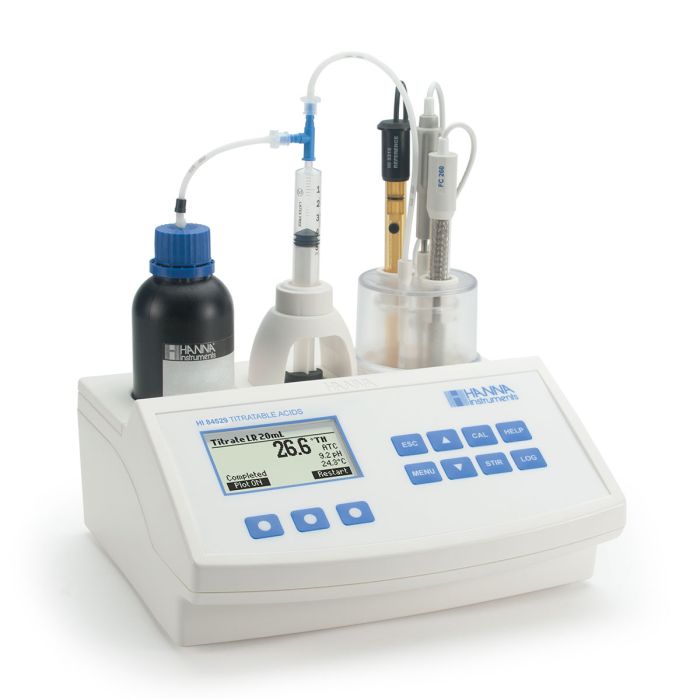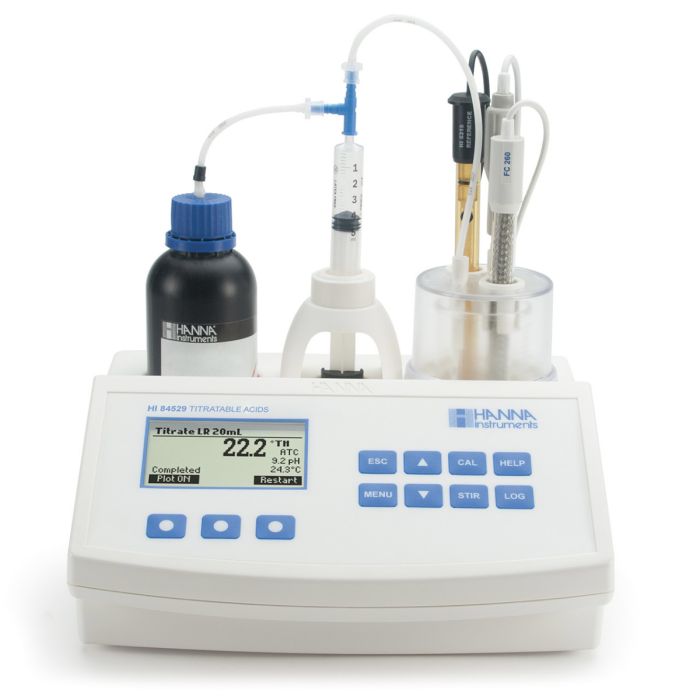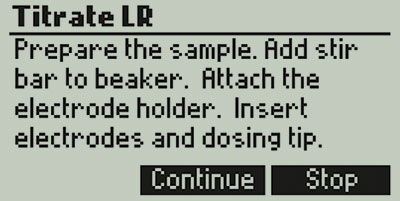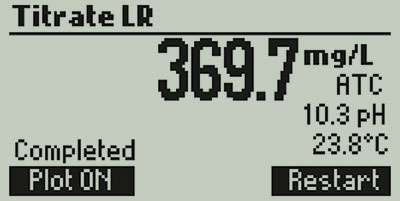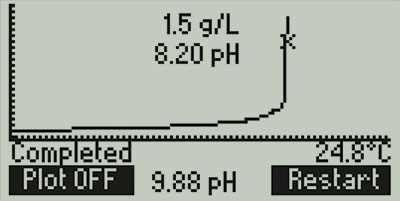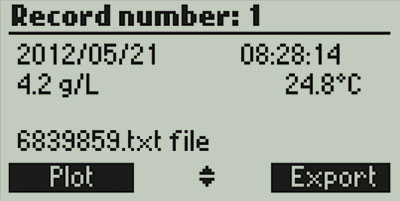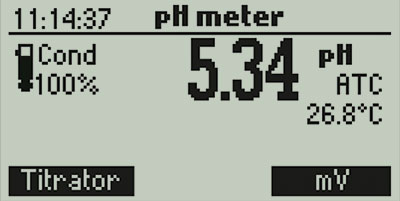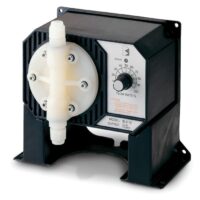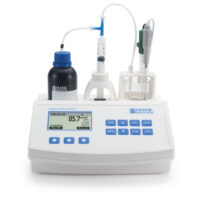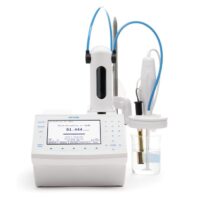The HI84529 uses methods based on AOAC International and Standard Methods for the Examination of Dairy Products. Both of these methods report titratable acidity as % lactic acid and a conversion factor is used to convert the results to the other available units. The HI84529 can be customized to meet the needs of any dairy analysis lab. Samples can be titrated by weight or volume, diluted or non-diluted (low range only) and titrated to a fixed pH endpoint that can be adjusted by the user. The HI84529 offers three different methods depending on the expected range and the weight of sample used. Select low range 50 to titrate a 50 mL or 50 g undiluted sample. The other titration options are low range 20 and high range 20 to titrate 20 mL or 20 g samples that are diluted twice their volume with deionized or distilled water.
There are two fundamentally different measurements of dairy products: titratable acidity and pH. pH is a measurement of hydrogen ion concentration while titratable acidity is the neutralizing capacity of a dairy product with NaOH. An increase in acidity can be caused by bacteria formation. Monitoring acidity is a way of determining the quality and freshness of dairy products. Acidity is determined by a pH endpoint titration using NaOH (sodium hydroxide), and is defined as the consumption necessary to shift the pH value from 6.6 (corresponding to fresh milk) to a pre-determined pH value. When using phenolphthalein as an indicator, a faint pink color change occurs at pH 8.3.
Titratable acidity is expressed in a variety of units based on the titration method performed. Each method varies in sample size and strength of NaOH used for the titration.
% Lactic Acid (%l.a.): Determined by taking a 20 mL or 20 g sample and diluting with twice its volume with deionized or distilled water. The sample is then titrated with 0.1 M NaOH to a phenolphthalein endpoint.
Degree Soxhlet Henkel (°SH): Determined by titrating a 50 mL sample with 0.1 M NaOH to a phenolphthalein endpoint.
Degree Dornic (°D): Determined by titrating a 100 mL sample with N/9 NaOH to a phenolphthalein endpoint.
Degree Thörner: Determined by taking a 10 mL sample and diluting with twice its volume with deionized or distilled water. The sample is then titrated with 0.1 M NaOH to a phenolphthalein endpoint.
Knowing the relationship between sample weight or volume and strength of titrant it is possible to convert the reading obtained from one method to another. Below is a table with the factors preprogrammed in the HI84529 for converting between various units of measure.
| From: |
To: |
Divide By: |
| %l.a. |
°SH |
0.0225 |
| %l.a. |
°D |
0.0100 |
| %l.a. |
°Th |
0.0090 |
Table for converting % lactic acid (%l.a.) to Degree Soxhlet Henkel (°SH), Degree Dornic (°D), and Degree Thorner °Th.
Application-Specific Half-Cell pH Electrode
The HI84529 is supplied with the FC260B half-cell glass body pH electrode. A pH half-cell electrode consist only of the pH indicating electrode. There is no reference cell with a junction. The FC260B half-cell electrode uses low temperature (LT) glass with a spherical bulb and glass body. This design consideration is ideal for direct pH measurement or titration of dairy related products.
Low Temperature Glass Formulation
The glass tip uses a special LT glass formulation with a lower resistance of approximately 50 megaohms compared to general purpose (GP) with a resistance of about 100 megaohms. This is beneficial since many dairy products are stored at low temperatures. As the temperature of the glass decreases in the sample, the resistance of the LT glass will increase approaching that of GP glass at ambient temperatures. If using GP glass, the resistance would increase above the optimum resistance for the high impedance input of a pH meter. The FC260B is suitable to use with samples that measure from -5 to 100℃.
Reference Half-Cell
Most pH electrodes are combination pH electrodes in which both half cells are supplied in a single probe design. The reference cell of these electrodes typically have a junction made of ceramic, glass, or PTFE. The junction of a reference electrode provides the electrical pathway between the inner portion of the electrode and the sample The HI84529 is supplied with the HI5315 reference half-cell. The HI5315 has a skirted cone junction that allows for an extremely stable reference voltage with the sample. The HI5315 features a plunger design that can be used to flush any solids that have accumulated at the junction surface. The HI5315 can also be completely disassembled for cleaning. The ability to maintain a clean open junction allows for repeatable and accurate measurement.
Piston Driven Dosing Pump
The heart of the HI84529 is the piston driven burette pump. This type of dosing system uses a motor in which each dose is very precisely controlled and the volume dispensed is accurately determined. The piston driven burette is controlled dynamically so that the volume of titrant being dosed is automatically adjusted based on a voltage response of the previous dose. This type of dosing speeds up the titration process by allowing for more titrant to be dosed at the start of the titration and then very small doses as the endpoint is reached.
Custom pH Calibration
According to AOAC International and Standard Methods for the Examination of Dairy Products the titration endpoint for % lactic acid is pH 8.3. The HI84529 uses custom calibration points based on the pH of fresh milk and the titration endpoint. The preprogrammed pH 6.00 and pH 8.30 calibration points allows for calibration of the meter that brackets the pH readings.
Good Laboratory Practice
The HI84529 offers comprehensive GLP information including date and time of the last pH electrode and dosing pump calibrations. Tracking calibrations are critical to have confidence in the results obtained from titrations. The GLP data is stored along with any logged readings.
Automatic Stirrer
The built-in stirrer is automatically maintained at a speed of 800 rpm for low range titrations and 1000 rpm for high range titrations, regardless of the viscosity of the solution being titrated.
On-Screen Features
Easy-to-Use InterfaceThe HI84529 has an intuitive user design with clearly defined keys and a large screen that is easy to navigate. The meter has a built-in tutorial mode that, when enabled, will walk the user step by step through the titration process. A dedicated HELP key is always available to allow access to content-specific information during both calibration and titration.
Procedure Warnings Users are warned if there is an error in procedures such as the titration exceeded the maximum volume of titrant.
Graphic Mode This mini titrator displays in-depth data during titration, including a real-time graph of the titration curve.
Log-on-DemandThe HI84529 allows for data logging of up to 400 samples: 200 titration results and 200 pH/mV readings. Data can be stored and exported to a USB drive or a PC using the USB connection.
pH/mV MeterIn addition to being an automatic titrator, the HI84529 also can be used as a pH/mV meter. As a pH meter, it has many features of a professional grade benchtop including automatic calibration up to three points with four available buffers, a 0.01 pH resolution, accuracy of ±0.01 pH, automatic temperature compensation and comprehensive GLP data.
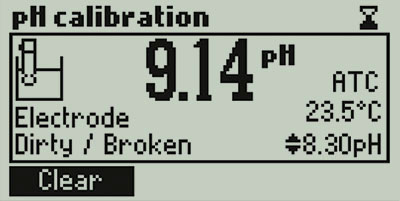
CAL Check™ Accuracy is always ensured with Hanna’s unique CAL Check feature, which analyzes the response of the electrode during the calibration process. Based on electrode response in the buffer, indicators are displayed on screen to alert the user of potential problems during calibration. These indicators include Buffer Contaminated, Electrode Dirty/Broken, and overall probe condition. The CAL Check function not only ensures an accurate pH reading when the HI84529 is used as a pH meter, but also an accurate titration since the endpoint of a titratible acidity titration is determined by a set pH value.
Ordering info
HI84529-02 is supplied with:
- FC260B pH electrode
- HI5315 reference electrode
- HI7662-M temperature probe
- HI84529-50 low range 20 titrant (120 mL)
- HI84529-52 low range 50 titrants (120 mL)
- HI84529-51 high range 20 titrant (120 mL)
- HI84529-55 calibration standard (230 mL)
- HI7072 fill solution (30 mL)
- HI700640 cleaning solution for milk deposits (2 x 20 mL)
- Capillary dropper pipette
- 100 mL beakers (2)
- Dosing pump valve
- 5 mL syringe
- 1 mL plastic pipette
- Tube set (aspiration tube with titrant bottle cap and dispensing tube with tip)
- Stir bar
- 12VDC power adapter
- Instruction manual
- Quality certificate
Purchase & Shipping
All prices are inclusive of GST and not all items are stock items, if you require an immediate solution please send an email to sales@hannainst.com.au or call us on (03) 9769 0666.
Free standard delivery: We offer free delivery within Australia on orders over $150, typically arriving within 5 to 7 days. Delivery times may vary depending on the courier service and the recipient’s location. Free shipping is not available with other offers or discounts.
Same-day dispatch: Place your order before 1 PM Monday to Friday for same-day despatch (leaves our warehouse). Delivery times may vary depending on the courier service and the recipient’s location. Subject to stock availability.
Please note that we do not offer shipping to PO Box addresses.
